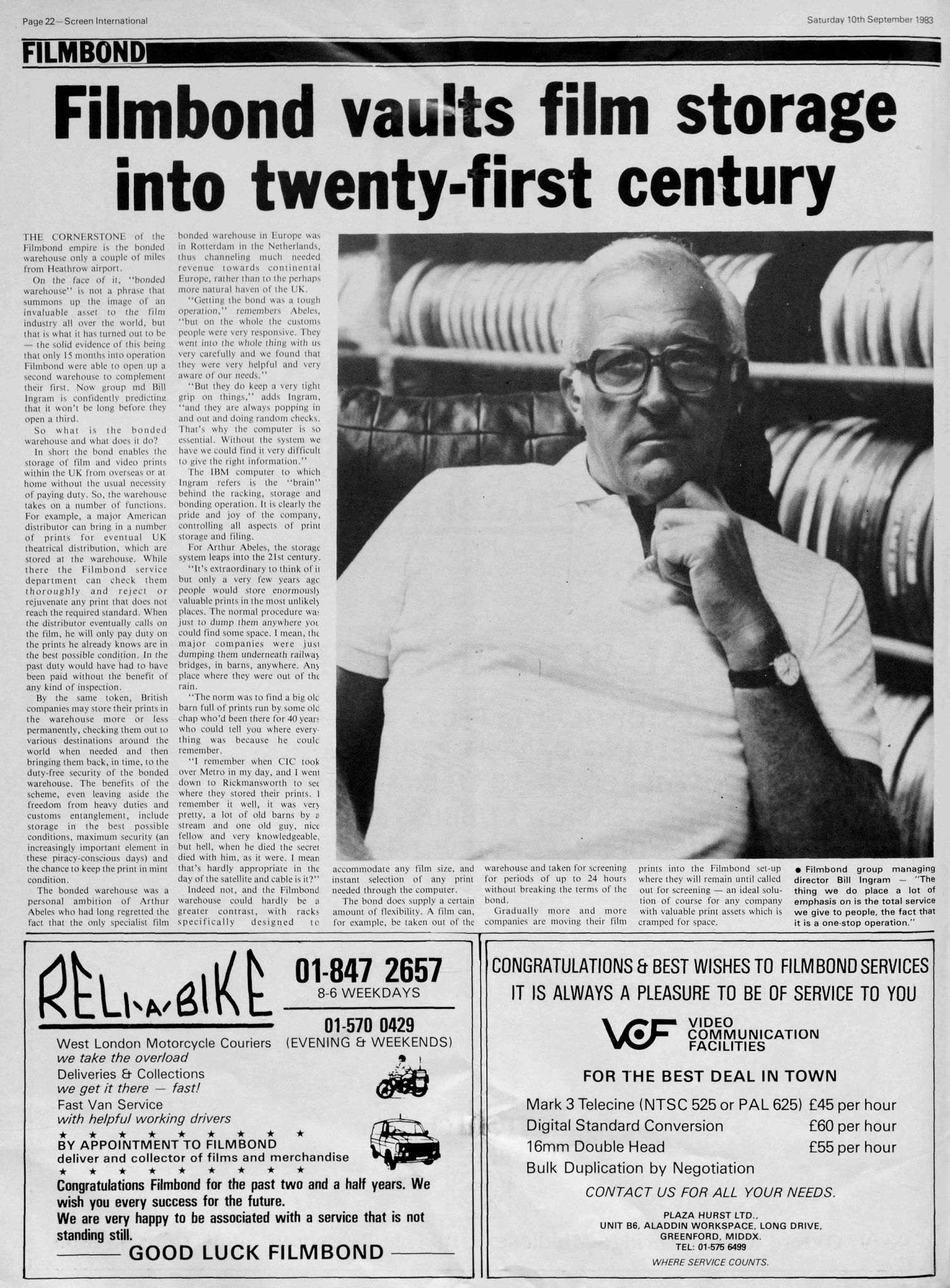Screen International (10/Sep/1983) - Filmbond vaults film storage into twenty-first century
Details
- article: Filmbond vaults film storage into twenty-first century
- publication: Screen International (10/Sep/1983)
- publisher: EMAP
- keywords: Albert William Ingram (b. 1928)
Article
Filmbond vaults film storage into twenty-first century
The cornerstone of the Filmbond empire is the bonded warehouse only a couple of miles from Heathrow airport.
On the face of ii, "bonded warehouse" is not a phrase that summons up the image of an invaluable asset to the film industry all over the world, bill that is what ii has turned out to be — the solid evidence of this being that only 15 months into operation Filmbond were able to open up a second warehouse to complement their first. Now group md Bill Ingram is confidently predicting that ii won't be long before they open a third.
So what is the bonded warehouse and what does it do?
In short the bond enables the storage of film and video prints within I he UK from overseas or at home without the usual necessity of paying duty. So, the warehouse takes on a number of functions. For example, a major American distributor can bring in a number of prints for eventual UK theatrical distribution, which are stored at the warehouse. While there the Filmbond service department can check them thoroughly and reject or rejuvenate any print that does not reach the required standard. When the distributor eventually calls on the film, he will only pay duty on the prints he already knows are in [lie best possible condition. In the past duty would have had to have been paid without the benefit of any kind of inspection.
By the same token, British companies may store their prints in the warehouse more or less permanently, checking them out to various destinations around the world when needed and then bringing them back, in time, to the duty-free security of the bonded warehouse. The benefits of the scheme, even leaving aside the freedom from heavy duties and customs entanglement, include storage in the best possible conditions, maximum security (an increasingly important element in these piracy-conscious days) and the chance to keep the print in mint condition.
The bonded warehouse was a personal ambition of Arthur Abeles who had long regretted the fact that the only specialist film bonded warehouse in Europe was in Rotterdam in the Netherlands, thus channeling much needed revenue towards continental Europe, raiher than to the perhaps more natural haven of the UK.
"Getting the bond was a tough operation," remembers Abeles, "bin on the whole the customs people were very responsive. I hey went into (he whole thing with us very carefully and we found that I hey were very helpful and very aware of our needs."
"But they do keep a very tight grip on things," adds Ingram, "and they are always popping in and out and doing random checks. That's why the computer is so essential. Without the system we have we could find ii very difficult 10 give the right information."
The IBM computer to which Ingram refers is the "brain" behind the racking, storage and bonding operation. It is clearly the pride and joy of the company, controlling all aspects of print storage and filing.
For Arthur Abeles, the storage system leaps into the 21st century.
"It's extraordinary to think of it but only a very few years age people would store enormously valuable prints in the most unlikely places, the normal procedure was just to dump them anywhere they could find some space. I mean, the major companies were just dumping them underneath railway bridges, in barns, anywhere. Any place where they were out of the rain.
"The norm was to find a big old barn full of prints run by some old chap who'd been there for 40 years who could tell you where everything was because he could remember.
"I remember when CIC took over Metro in my day, and I went down to Rickmansworth to sec where they stored their prints. I remember it well, it was very pretty, a lot of old barns by a stream and one old guy, nice fellow and very knowledgeable, but hell, when he died the secret died with him, as it were. I mean that's hardly appropriate in the day of the satellite and cable is it?"
Indeed not, and the Filmbond warehouse could hardly be a greater contrast, with racks specifically designed to accommodate any film size, and instant selection of any print needed through the computer.
The bond does supply a certain amount of flexibility. A film can, for example, be taken out of the warehouse and taken for screening for periods of up to 24 hours without breaking the terms of the bond.
Gradually more and more companies arc moving their film prints into the Filmbond set-up where they will remain until called out for screening — an ideal solution of course for any company with valuable print assets which is cramped for space.

